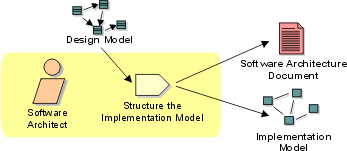Workflow Detail: Structure
the Implementation Model
|
The purpose of this workflow detail is to structure the implementation to ensure a smooth implementation and integration/build process. |
|
|
|
Description

Structuring the implementation model generally results in a set of Implementation Subsystems that can be developed relatively independently. A well-organized model will prevent configuration management problems and will allow the product to built-up from successively larger integration builds.
Related Information 
This section provides links to additional information related to this workflow detail.
Timing 
Starts in Elaboration phase, recurs through Construction and Transition phases as needed.
Optionality 
Recommended for larger systems. Optional for smaller systems.
How to Staff

While the software architect has primary responsibility for the structure of the implementation model, the software architect's experience needs to include that of an integrator at the system level. They need experience in software build management, configuration management, and experience in the programming language in which the components to be integrated are written. Because the automation of integration will be handled by the integrator, the software architect need not be an expert in scripting or integration automation, but some familiarity with the topic will often help the build process go more smoothly.
Work Guidelines

Structuring the implementation model should be done in parallel with the evolution of the other aspects of the architecture; failure to consider it early in the architecting process may lead to poor organization of the implementation and may impede the implementation and build process. In the worst case, a poorly organized implementation model will impede parallel development of software by the project team.

